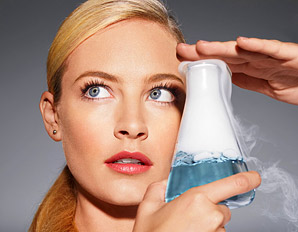
A very long time ago a reader asked me to address the issue of mineral oil in my blog. I am just now getting around to writing this post. My apologizes to that reader.
Let me start off with information about mineral oil that I found on the holistic lifestyle website The Chalk Board:
Toxic Tuesday Ingredient Focus: Mineral Oil (aka Paraffinum Liquidum)
WHAT IS IT? An extremely cheap & common petroleum derivative (refined crude oil petrochemical) which is found in 98% of skincare products sold in the US.
HEALTH RISK: Petrochemicals contain neurotoxins which damage the nervous system. Mineral oil forms a film on the surface of your skin that can not be absorbed, thereby blocking the pores and the skin’s natural respiration. It traps dirt and bacteria and blocks the absorption of vitamins/minerals/botanicals that may be in a product. John Hopkins University named mineral oil in cosmetics and moisturizers as the number two cause of aging (first being direct exposure to sun). It may also cause allergic reactions and dryness, as well as promote acne and other skin disorders.
Oy! If I took everything I read at face value I would be throwing out my beauty products right now instead of writing this post. Scary information, right? Extreme information, right? (I recently did a training with a very well known international skincare company during which the trainer repeated the same information about mineral oil that you see above) So what’s the truth about mineral oil? What was written above or is it something else?
In his book The New Ideal in Skin Health Dr. Carl Thornfeldt devotes three pages just to the topic of mineral oil. He debunks the information above (pages 377-380):
One of the most widely used ingredients for moisturizers is the first controversial ingredient we will cover. Petrolatum (also known as petroleum jelly and white petroleum) and mineral oil have been much maligned from “natural” based cosmetics companies, internet consumer sites and other environmental groups. These sources erroneously claim that petrolatum and mineral oil are terrible ingredients because they come from crude oil (petroleum) which causes harm to the skin by forming an occlusive oil film, thereby “suffocating” it. Unfortunately for these sources, this claim defies known human biology. In the body oxygen is transported to the skin by the blood supply, and then diffuses into the epidermal cells – oxygen is not absorbed directly from the air. Herbal mucilages have been used for wound healing to soothe, protect and heal damaged or abnormal skin for centuries. These mucilages naturally mimic the occlusive activity of petrolatum and mineral oil. However, the “suffocating” claim is never used to dissuade use of those types of products.
Mineral oil, also known as soft paraffin, is the liquid form of petrolatum. All of these ingredients consist of mixtures of hydrocarbons that are byproducts of crude petroleum distillation; thus they are all actually organic, natural ingredients. …
Mineral oil reduces TEWL (transepidermal water loss) by 40%, is equally as occlusive as coconut oil and more occlusive than linoleic acid, yet it does not induce acne. Mineral oil and petrolatum provide inhibition of excessive inflammatory activity superior to 1% hydrocortisone is treating soap induced contact irritant dermatitis conducted by this author. It has also been documented these ingredients have anticarcinogenic and mild antibacterial effects.
Many of these misconceptions regarding safety and efficacy of these ingredients are directly related to the quality of the grade. Technical grade is the least unpurified form of the oil, and is commonly used by machinists to lubricate engines and equipment. It is known to induce contact reactions in 10-50% of the machinists. Cosmetic grade is a more purified option. The highest standard is United States Pharmacopeia (USP) pharmaceutical grade, which indicates that it is essentially free of impurities. …
Prescription pharmaceuticals and some cosmetic companies do use the highest quality USP grade in their marketed formulations. Cosmetic companies are not required to use USP grade, even though USP grade mineral oil and petrolatum are considered the safest, least irritating moistutrizing ingredients ever found in the skin care industry. In addition, they are commonly used as a “vehicle” for most substances used in patch testing by dermatologists due to their nonirritating and nonsensitizing properties. This is a medical diagnostic process used to determine if one is allergic to ingredients in products applied to the skin.
Neither pharmaceutical nor cosmetic grades of petrolatum or mineral oil are considered comedogenic when using the standardized comedogenicity testing. With the highest comedogenicity rating at 5, these ingredients have tested at a 0-1 rating. This rating indicates the increased impurities in lower grades appear to be the major cause of adverse reactions including comedogenicity, contact irritant and allergic dermatitis. …
As to claims that people react negatively even to USP grade petrolatum or mineral oil, to date all compounds used in skin care have at least one documented positive patch test response. Even purified water applied to the skin may activate hives in people afflicted with a disease called aquagenic pruritus. Thus, while safety testing is imperative, there can always be the exceptional patient that may react negatively to even the safest known ingredient.
If that information isn’t enough to persuade you that mineral oil in skincare products is ok let me present some more evidence. The Beauty Brains debunked five long-held myths about mineral oil in their post The Top 5 Myths About Mineral Oil – Part 1:
We often see the advice that people should avoid mineral oil at all costs.
This idea is propagated by numerous “natural” companies. Well, this advice is just bogus. It’s not based on any scientific studies. Mineral oil is a perfectly fine ingredient and has been used in cosmetics for over 100 years.
Here are the top 5 Myths that companies tell people to make them afraid of mineral oil.
Mineral Oil Myths
1. Mineral oil is contaminated with carcinogens. While it’s true that some petroleum derivatives contain carcinogenic materials (like some polycyclic aromatic compounds) the mineral oil that is used in the cosmetic and pharmaceutical industry is highly refined and purified. It’s purity is even regulated by the US FDA and other international regulatory agencies. There is absolutely no evidence that cosmetic grade mineral oil causes cancer. And there has been plenty of testing done to ensure that fact. We could find no published reports in any of the dermatological or medical journals indicating a link between mineral oil and any forms of cancer.
2. Mineral oil dries the skin and causes premature aging. Mineral oil works as a barrier between the skin and the air. It acts as an occlusive agent which prevents water from naturally leaving your body through your skin. It will not dry out your skin or cause premature aging. Quite the contrary. It will provide moisturization.
3. Mineral oil robs the skin of vitamins. Since many vitamins are oil based, people assume that mineral oil will pull them out of your skin. There is no legitimate scientific evidence that this is true. Mineral oil has no effect on the vitamin levels in your skin.
4. Mineral oil prevents absorption of collagen from collagen moisturizers. Collagen in your skin lotions and moisturizers is too big to actually penetrate your skin. Therefore, mineral oil will have no effect on whether the collagen gets absorbed or not.
5. Mineral oil causes acne. In some people, mineral oil can exacerbate acne problems. However, most people will not experience any problems.
So, if it is not for safety concerns, why would companies be telling you to avoid mineral oil? We’ll look at that in part 2 of our series.
The Beauty Brains Bottom line. Mineral oil is NOT bad for you or your skin. It is one of the best ingredients available in skin lotions and moisturizers. It is also 100% natural taken directly out of our dear Mother Earth.
Next I’ll turn to the blog Lab Muffin to further debunk a few mineral oil myths (From the posts – Is Mineral Oil Dangerous? Part 1 and Is Mineral Oil Dangerous? Part 2):
Mineral oil comes from crude oil… I’m not putting gasoline on my face! – FALSE
While it’s true that mineral oil comes from crude oil, it doesn’t mean that its properties are the same, or even similar to gasoline!
Crude oil is formed when biological material (from algae and plankton) gets buried under the sea. Over millions of years, the pressure transforms the carbon-containing compounds in the once-living tissue into the carbon-containing compounds which make up crude oil.
Crude oil contains lots of different things, mainly made up of carbon and hydrogen only. After it’s been pumped out of the ground, it has to be refined to separate out the different bits.
Apart from mineral oil and gasoline, things that come from crude oil include paraffin wax (found in most candles, and in cheese wax) and asphalt/bitumen. And as you know, candles and gasoline and asphalt are completely different! So just because it comes from the same stuff at the beginning doesn’t mean it’ll look, act or be the same.
Mineral oil is comedogenic and will make you break out – FALSE
Mineral oil appears on a large range of “comedogenic ingredients” lists. Once upon a time (well, in the 1970s), cosmetic companies noticed that a lot of women started getting acne from their makeup products. One scientific study on comedogenicity used the inside of a rabbit’s ear to test whether products caused pimples, and this quickly became the test of choice. However, later on, they found that sometimes the results on a rabbit and the results on a human were different. (Lab Muffin loves rabbits, and this made her sad, because an awful lot of rabbits got ear pimples for no good reason!)
A later study tested products containing between 0 and 30% mineral oil, and found that it wasn’t comedogenic on human skin. The best thing about mineral oil is that (unlike a lot of plant oils) it’s incredibly stable – it doesn’t oxidise, and stays liquid. In other words, it’s not likely to clump up later on, after reacting with oxygen and light, and clog your pores! However, this doesn’t mean that it won’t cause you to break out, since different people respond differently to certain ingredients.
It just sits on top of skin – it doesn’t moisturise! It suffocates your skin – PARTLY FALSE
There are three ways in which moisturisers moisturise – occlusive (covering your skin up so water can’t evaporate), humectant (grabbing water and keeping it next to your skin) and emollient (makes your skin feel soft) actions. Mineral oil is an excellent occlusive, so yes, it does just sit on top of your skin – but it definitely moisturises! In fact, scientists often use it as a standard for comparing other moisturisers. Of course, if you have dry skin to begin with, just putting mineral oil isn’t going to work so well (if there’s not enough water to begin with, there’s not much water to keep in!).
As to whether skin can be suffocated – skin is porous, but it doesn’t really need to “breathe”. What people usually mean by “letting your skin breathe” means washing off the dirty gunk from your pores… dirt can stick to mineral oil, just like it can stick to anything else on your face.
Because mineral oil is really good at being an occlusive, it’s possible that it can block certain nutrients in your cream from reaching your skin – the solution is to put on the active ingredient first, then cover it up with the mineral oil, and the mineral oil will keep that stuff on your skin.
Lastly, now that my sources have debunked the different myths about mineral oil perhaps you are asking yourself – if mineral oil is good for our skin why do I need another moisturizer? Once again I’ll turn to The Beauty Brains to explain (from Why Can’t I Just Use Mineral Oil?):
Yashendwirh says…I’ve read here and several other blogs that mineral oil, vitamin-E and a few other very inexpensive products are both hydrating and non-comedogenic. Would that make them effective every day go-to moisturizers? That said, what is the benefit of spending anything more than the couple bucks it costs for these products on expensive moisturizer formulas? Even inexpensive ones that are $10-$20 seem expensive compared to the $3 it costs for an absolutely enormous bottle of mineral oil? We know it works, why would we throw our money at anything else? Would I be doing my skin a massive disservice by forgoing my current moisturizer (clinique gel) in favor of using mineral oil long term?
The Right Brain replies
You certainly won’t be hurting your skin by using mineral oil but you may be missing out on some of the benefits of a fully formulated product. Here are three examples:
1. Balanced moisture
Fully formulated lotions contain water and ingredients that can attract water to your skin like glycerin. You won’t get that with just mineral oil.
2. Non-greasy feel
Compared to modern lotion formulas which feel nice and soft on the skin mineral oil can leave you feeling a bit, well, oily.
3. Special function ingredients
Creams and lotions can deliver sunscreens and retin-A which are both important anti-aging ingredients that you won’t get from just mineral oil.
Bottom Line: Don’t let mineral oil scare you. It’s an effective and worthwhile skincare ingredient.
Further Reading:
Image from thechalkboardmag.com




 The term chiral is derived from the Greek work for handedness and a molecule is called chiral if it differs from its mirror image. (A simple way to visualize this concept is to think of your right and left hand. You can`t fit your left hand in your right glove, right? That`s because they`re chiral. You can learn more about the idea
The term chiral is derived from the Greek work for handedness and a molecule is called chiral if it differs from its mirror image. (A simple way to visualize this concept is to think of your right and left hand. You can`t fit your left hand in your right glove, right? That`s because they`re chiral. You can learn more about the idea 







Recent Comments